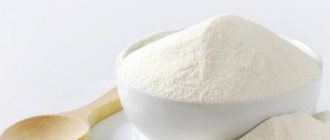Growing and ✅ strengthening muscles become MORE IMPORTANT as we AGE because they help maintain independence and the ability to easily handle everyday tasks such as climbing stairs and carrying groceries from the grocery store.
If you are interested in muscle growth and definition, this cannot be achieved without exercise. However, while working out helps build muscle, it won't do much good if you're not eating well. Most often, people believe that to achieve muscle definition, you need to eat a lot of protein and carbohydrates. However, nutrition concepts are not so simple. For example, even when you don't have enough food, your body has a mechanism to build muscle mass.
PPARγ agonists prevent sarcopenia by regulating glucose metabolism
Activation of PPARγ receptors (Peroxisome proliferator-activated receptor gamma) allows increasing sensitivity to insulin, a hormone that regulates blood glucose levels, which helps reduce intermuscular fat. And intermuscular fat is one of the reasons for decreased muscle mass. PPARγ receptor agonists are promising agents for the treatment of sarcopenia.
Source link:
- https://it.wikipedia.org/wiki/PPAR-γ
Telmisartan is one of the drugs in the sartan group, which, in addition to lowering blood pressure, has an additional property - agonism to PPARγ receptors . Of all the sartans, telmisartan is the most potent PPAR-γ activator and is approximately 20 times more potent than losartan. In wild-type mice, long-term administration of telmisartan results in increased running endurance, decreased body fat, and an increased proportion of Type I muscle fibers. Type I fibers are rich in mitochondria and are resistant to fatigue. It is because of these properties that there was a proposal in 2016 to add telmisartan to the list of doping agents for athletes. Therefore, for people with high blood pressure to protect against sarcopenia, telmisartan is the drug of choice.
Link(s) to study(s):
- https://onlinelibrary.wiley.com/doi/10.1111/j.1582-4934.2010.01085.x/full
- it.wikipedia.org/wiki/PPAR-γ
A 2008 study from the University of Florida in the US examined the effects of a low-calorie diet on glucose metabolism and associated protection against sarcopenia. Preliminary observations suggest that small (up to 8%) reductions in food intake may have a protective effect against sarcopenia in aging. This means that you need to get into the habit of leaving the table with a slight feeling of hunger.
Link(s) to study(s):
- www.ncbi.nlm.nih.gov/pubmed/18191752
- www.ncbi.nlm.nih.gov/pubmed/16677097
Fenofibrate is a medicine to treat high blood cholesterol. Fenofibrate activates peroxisome proliferator-activated receptors alpha (PPAR alpha). In this regard, scientists at Anhui University in China studied fenofibrate from the point of view of its effect on muscle aging. A study was published in 2020 and found that fenofibrate reduced inflammation in skeletal muscle and thereby protected it from sarcopenia. A 2020 study from the Norwegian University of Science and Technology found that fenofibrate protected muscle against aging during menopause, an estrogen-deficient condition in female rats. Rats were treated with fenofibrate for 8 weeks. After treatment, the rats jumped higher than before treatment. It is worth noting that people are prescribed statins to lower cholesterol, which, on the contrary, worsen the condition of muscle mass. And if a person needs to reduce cholesterol and treat sarcopenia, then fenofibrate is preferable to use. But you cannot combine fenofibrate with statins at the same time - this is dangerous. Fenofibrate should not be used by people with elevated creatinine in blood tests or with a reduced glomerular filtration rate. And of course it cannot be used without a doctor’s prescription.
Link(s) to study(s):
- www.ncbi.nlm.nih.gov/pubmed/27297630
- www.ncbi.nlm.nih.gov/pubmed/27526032
Metformin, a medicine for the treatment of type 2 diabetes mellitus, is also a PPAR-gamma receptor agonist. A 2014 human study conducted by the University of Texas Health Science Center (see figure left) in San Antonio, USA, found that the main mortality-reducing effect of metformin was due to a reduced risk of frailty due to loss of muscle mass and other causes of frailty. . Researchers studied 2,415 patients with type 2 diabetes aged 65 to 89 years from 1999 to 2006. We considered patients who were prescribed only metformin (without other glucose-lowering drugs) for the treatment of diabetes mellitus for at least 180 days. Patients with kidney disease, liver disease, and oncology were also excluded. It turned out that a 23% reduction in mortality among those taking metformin was associated precisely with the prevention of the onset of frailty. So for people who were already frail when metformin was prescribed, this medicine did not reduce mortality. This means that the prolongation of life with metformin was mainly associated with the prevention of the development of frailty.
Link(s) to study(s):
- www.ncbi.nlm.nih.gov/pubmed/27978584
- www.ncbi.nlm.nih.gov/pubmed/25506599
Following these promising results from metformin, a clinical trial of metformin was initiated to prevent muscle loss in diabetic patients. The clinical trial is being conducted by the University of Kentucky in the USA (see picture on the left). The fact is that in a number of diabetic patients in old age, training muscle mass does not produce results, and sometimes even on the contrary, the size of muscle mass decreases. But it has been hypothesized that metformin may block muscle insensitivity to exercise in some diabetic patients. Older patients are given 1700 mg of metformin per day or placebo. At the same time, patients train on simulators. According to scientists, metformin should increase the effectiveness of training. The results will be ready in 2017-2018.
Link(s) to study(s):
- www.ncbi.nlm.nih.gov/pubmed/28441958
A 2016 study from the Catholic University of the Sacred Heart in Italy examined the effects of a ketogenic diet with amino acid supplementation in a clinical trial on sarcopenia. The amino acid ketogenic diet was highly effective for weight loss without losing muscle mass.
Link(s) to study(s):
- www.ncbi.nlm.nih.gov/pubmed/27383313
Yes. Anyone who uses a ketogenic diet should definitely drink BCAA amino acids (which can be bought at a sports store or ordered here ) so that on a ketogenic diet there is no sarcopenia, but on the contrary, the muscles are better.
You skip meals
If you look at the clock at six in the evening and realize that you haven't eaten since breakfast, you're not only starving yourself, but also your muscles. If you cut calories, it can negatively impact your health, preventing you from achieving certain goals. In the fitness world, certain techniques such as cutting calories have gained popularity in recent years, but this is not the smartest solution since your body needs calories to maintain muscles and allow them to grow. Such a habit will likely cause your metabolism to slow down, and your body will begin to lose muscle tissue and retain fat. Therefore, you should always eat healthy and balanced so that your metabolism speeds up and your muscles always have the necessary fuel.
Suppressing muscle inflammation prevents sarcopenia
A 2002 study conducted by the University Medical Center in the Netherlands examined vitamin D3 in terms of the effects of vitamin D deficiency in the blood on muscle mass. With a deficiency of vitamin D in the blood, muscle atrophy occurs (mainly in type II fibers) due to inflammation.
Link(s) to study(s):
- www.ncbi.nlm.nih.gov/pubmed/11916748
A 2008 study from the University of Southampton (UK) found in 2,983 patients aged 59 to 73 that eating fatty fish (or fish oil ) may be essential for restoring skeletal muscle strength by modulating inflammation. Similar results were shown in a 2012 randomized controlled trial conducted by the Federal University of Parana (Brazil), as well as in a 2020 study conducted by McMaster University in Canada.
Link(s) to study(s):
- www.ncbi.nlm.nih.gov/pubmed/9467429
- www.ncbi.nlm.nih.gov/pubmed/18005355
- www.ncbi.nlm.nih.gov/pubmed/21159787
- www.ncbi.nlm.nih.gov/pubmed/21501117
- www.ncbi.nlm.nih.gov/pubmed/22218156
- www.ncbi.nlm.nih.gov/pmc/articles/PMC4496741
Increase your physical activity
In the absence of contraindications to sports, this is the best way to build muscle mass. Any aerobic exercise or complex cardio endurance training works well as a physical activity. You can use exercise equipment: an exercise bike or a treadmill.
For older people who suffer from chronic fatigue and constant weakness, short (but daily) race walking at low speed or regular walks are suitable.
If your health allows, you need to add strength exercises with weights: they do a better job of restoring skeletal muscle mass than cardio exercises. The training program should include: weight lifting, expander stretching.
It is important to try to create and overcome loads that exceed the capabilities of the muscles. Then the muscle fibers will begin to stretch more, sending a signal to the brain to activate cell growth and restoration.
- DIY dog clothing patterns
- What haircut will rejuvenate you after 40
- Additional payment to pensions for coal industry workers for harmful activities
Other ways to prevent sarcopenia
HMB (β-hydroxy-β-methylbutyrate) is a metabolite of the amino acid leucine. This basically means that our body produces HMB from leucine. In addition to affecting muscle growth signaling elements, HMB also reduces the activity of protein breakdown in muscle. A 2016 study from the University of Montpellier in France examined β-hydroxy-β-methylbutyrate ( HMB ) and its role in reducing intermuscular adipose tissue to prevent muscle atrophy. As you can see in the graph on the left, consuming of HMB per day for 4 weeks increases muscle mass. But after 4 weeks, this effect begins to decrease - it makes sense to use HMB for no more than 4 weeks, and then take a break for 1 month . A 2015 study from Tianjin University in China and McMaster University in Canada also found β-hydroxy-β-methylbutyrate ( HMB ) supplementation to be effective in treating sarcopenia in people aged 65 years and older. But given that β-hydroxy-β-methylbutyrate ( HMB ) activates mTOR and suppresses autophagy, it makes sense to use this supplement in courses rather than constantly.
Link(s) to study(s):
- www.ncbi.nlm.nih.gov/pubmed/27106402
- www.ncbi.nlm.nih.gov/pubmed/26169182
- www.ncbi.nlm.nih.gov/pubmed/26178029
Hydroxymethylbutyrate ( HMB ) can be purchased at sporting goods stores or ordered online - link Now Foods, Sports Nutrition, Hydroxymethylbutyrate Powder, 3.2 oz (90 g).
You need sunshine
The best source of vitamin D is sunshine, and if you haven't seen it in a while, replacing it with vitamin D supplements may cause you to start losing muscle. Vitamin D has long been known to play an important role in the absorption of calcium, which ensures you have strong bones. However, it also plays a role in muscle building. What's more, as you age, your body is less able to absorb vitamin D, so you need to become more flexible to consume the amount of vitamin D you need. Try to get out into direct sunlight for a couple of minutes as often as possible, and talk to your doctor about getting your vitamin D levels checked. You may be in urgent need of nutritional supplements. If you check your levels, you will be able to understand if something is wrong with you, especially since most people suffer from a deficiency of this vitamin.
How it works?
The presented diet is based on reducing carbohydrate intake without negatively affecting hormone levels. Carbohydrates and fats are two of the most important components needed to maintain proper levels of testosterone, which is needed for burning fat and building muscle.
Even though the amount of carbohydrates you consume is reduced, you are still providing the body with enough nutrients to maintain adequate hormone levels and not fall into a state of catabolism.
For example, a bodybuilder who wants to reduce both calories and carbohydrates can afford to reduce them significantly before competition week and peak fitness. Most competitive athletes follow a similar pattern to the one described above.
Natural athletes spend most of their preparation for competition maintaining relatively high testosterone levels. In the last couple of weeks before a competition, as you reduce your calorie and carbohydrate intake, your hormone levels can become very disrupted for a short period of time. This is the reason why bodybuilders often use recovery diets after competitions.
Hormonal balance will be restored when you increase your caloric intake (mostly from carbohydrates). The bodybuilder will begin adding new layers of muscle to his frame and will hope to surpass himself by the time he next takes the stage.
Burn fat without losing muscle mass
For most guys who actively lift and want to lose fat, the important question is: “How not to lose muscle mass when you lift and lose weight?” Many dudes have excess fat that they want to lose. But I want to pump up a lot of quality meat, most often to be big and scary. Why, in a nutshell, do you need to gain muscle mass? In order to create an energy-intensive muscle corset. The presence of a muscle corset helps us keep bones, joints and organs in a reliable frame, protecting them from damage. In addition, the muscle corset is very energy-intensive and forces you to consume calories without saving in reserve. Of course, if you continue to engage in at least some physical activity.
The most effective types of training
Strength exercises
When performing strength exercises, the tension of your muscle fibers leads to activation of muscle cell growth signals, enhancing the action of growth and development hormones. These signals combine to trigger muscle cell growth and repair by creating new proteins and activating specialized muscle stem cells called satellite cells to help regenerate existing muscles (link). Thanks to this process, strength training is the shortest way to increase muscle mass and prevent muscle loss.
A study of 57 adults aged 65-94 found that doing strength training exercises three times a week increased muscle strength over 12 weeks.
Fitness
Long-term physical activity that increases your heart rate, including aerobic exercise and endurance training, may also control sarcopenia. Most studies of aerobic exercise for the treatment or prevention of sarcopenia also include strength and flexibility exercises in a combination of exercises.
These exercise combinations have shown good results for preventing and reversing the effects of sarcopenia, although it is unclear whether aerobic exercise without resistance exercise is as beneficial (link).
Another study examined the effect of aerobic exercise without strength training in 439 women over 50 years of age. The study found that cycling and jogging five days a week led to an increase in muscle mass. Women started exercising at 15 minutes a day, increasing to 45 minutes over 12 months (link).
Walking
Walking can also prevent and even reverse sarcopenia, and it's an activity that anyone can do for free.
A study of 227 Japanese people over 65 found that six months of walking increased muscle mass, especially in those who had low muscle mass (link). The walking distance was different for each participant, but everyone was advised to increase their total daily distance by 10% each month.
Another study of 879 adults over the age of 60 found that walking faster was effective in reducing signs of sarcopenia (link).
Conclusion: Exercise is the most effective way to combat sarcopenia. Strength training is best for increasing muscle mass and strength. However, a combination of exercise program and walking can also help combat sarcopenia.
Causes of sudden weight loss in men and diagnosis of the body
Tuberculosis is one of the most dangerous infections. She is difficult to treat. Among the causes of sudden weight loss in men, one of the most common is this disease.
Those most susceptible to TB are people with drug and alcohol addictions, prisoners, and people with nutritional deficiencies.
The infection is manifested by severe discomfort in the chest area, coughing attacks with the release of sputum and blood particles, profuse sweating, fever, and weakness.
Weight loss can also be caused by an inflammatory process in the lungs - pneumonia. Unlike tuberculosis, this pathology has an acute rather than chronic course.
Weight loss is a sharp spontaneous decrease in body mass index over a wide range. Despite the often-used definition of “unreasonable weight loss,” it is never truly unexplained.
The factors are either pathological (which happens more often) or physiological. According to medical statistics, approximately 15% of healthy men experience the described problem. Another 15% suffer from endocrine and other pathologies and do not suspect it until a certain moment.
Why does a seemingly healthy man begin to lose weight?
Sudden weight loss is an alarming symptom that requires immediate medical attention.
Disorder of the gastrointestinal tract
It also causes rapid weight loss. The causes in men can be various dysfunctions of the digestive organs.
Most often, weight loss occurs due to inflammation of the pancreas, which is accompanied by vomiting, abdominal cramps, profuse sweating and a gray discoloration of the skin.
Gastritis also refers to gastrointestinal diseases. It is characterized by discomfort in the upper abdomen, attacks of nausea, plaque formation on the surface of the tongue, and heartburn. Disturbances in intestinal activity are accompanied by diarrhea, flatulence and stool retention.
Weight loss in men after parasites enter the body is characterized by loss of appetite, a feeling of weakness, vomiting, fever, itching in the anus, and loss of hair.
Is it dangerous?
Regardless of what factors provoked a rapid decrease in body weight, this phenomenon can lead to serious illnesses. In this case, symptoms characteristic of any pathology are observed. In addition, the causes of sudden weight loss in men lead to general malaise.
What kind of weight loss is considered rapid? The answer to this question depends on the individual characteristics of the person. If a man weighs 150 kg, losing ten kilograms in 30 days is not a pathology. Losing weight like this will be beneficial. However, in other cases this situation is dangerous. For example, for a man who weighs 60 kilograms.
Experts say that if a person loses 10 kg in 30 days, they should seek medical help. Moreover, if there is a deterioration in the general condition. A decrease in body weight by 20%, compared to the initial indicators, threatens the health and life of the individual. Therefore, with significant weight loss in men, it is important to visit a doctor as soon as possible.
Symptoms
Weight loss may be accompanied by symptoms that vary depending on the underlying disease, disorder or condition. Symptoms that often affect digestion may also involve other body systems.
Gastrointestinal symptoms that may occur along with weight loss
Weight loss may be accompanied by symptoms affecting the digestive system, including:
- bloating and abdominal pain;
- bad breath;
- chronic constipation;
- dry mouth;
- weakened or painful teeth;
- mouth ulcers;
- nausea and vomiting;
- pale stools or abnormally foul-smelling stools;
- plump cheeks with swollen salivary glands;
- severe or chronic diarrhea.
Psychological symptoms that may occur along with weight loss
Weight loss may be accompanied by other symptoms that affect behavior or thoughts, including:
- throwing money left and right;
- depression;
- difficulties with memory, thinking, or poor judgment;
- excessive use of laxatives or diet pills;
- intentional vomiting;
- refusal to eat in the presence of other people.
Other symptoms that may occur along with weight loss
Weight loss may be accompanied by symptoms related to other body systems, including:
- bone and joint pain;
- dry, blotchy or yellowed skin covered with fine hair;
- extreme temperature sensitivity;
- loss of body fat;
- loss of muscle mass, muscle wasting, or muscle weakness;
- numbness or tingling in the arms or legs;
- rash, pimples, itchy skin, or darkening of the skin;
- weakness.
Serious symptoms that may indicate a life-threatening condition
In some cases, weight loss may be a symptom of a life-threatening condition that should be immediately assessed in emergency situations.
Call your doctor immediately
if
you have any of these life-threatening symptoms, including:
- confusion or loss of consciousness, even for a brief moment;
- labored breathing;
- dizziness;
- irregular heartbeat (arrhythmia);
- marked dehydration;
- severe abdominal pain;
- severe diarrhea;
- severe vomiting;
- vomiting blood.











